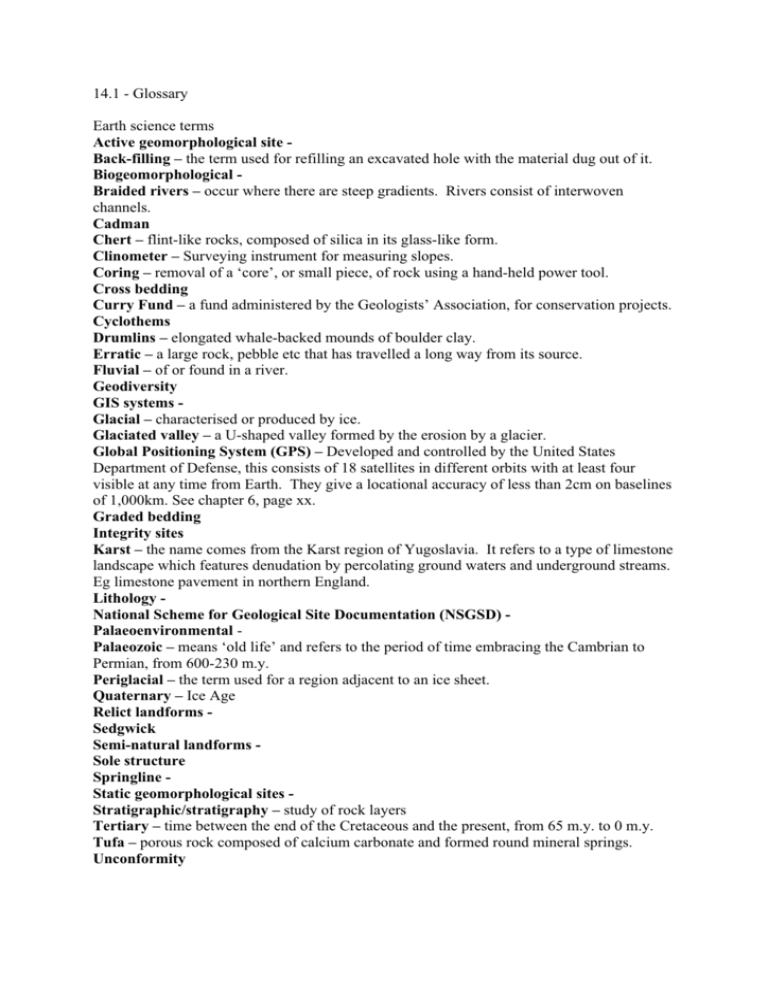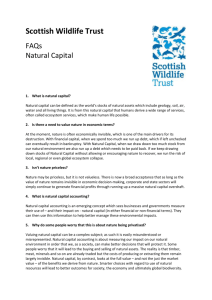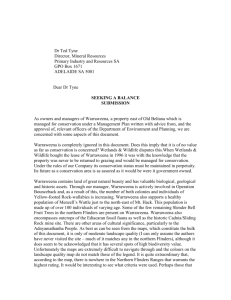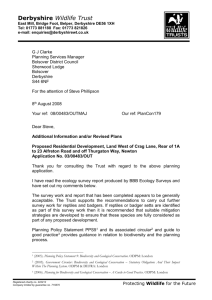14.1 - Glossary Earth science terms Active geomorphological site
advertisement

14.1 - Glossary Earth science terms Active geomorphological site Back-filling – the term used for refilling an excavated hole with the material dug out of it. Biogeomorphological Braided rivers – occur where there are steep gradients. Rivers consist of interwoven channels. Cadman Chert – flint-like rocks, composed of silica in its glass-like form. Clinometer – Surveying instrument for measuring slopes. Coring – removal of a ‘core’, or small piece, of rock using a hand-held power tool. Cross bedding Curry Fund – a fund administered by the Geologists’ Association, for conservation projects. Cyclothems Drumlins – elongated whale-backed mounds of boulder clay. Erratic – a large rock, pebble etc that has travelled a long way from its source. Fluvial – of or found in a river. Geodiversity GIS systems Glacial – characterised or produced by ice. Glaciated valley – a U-shaped valley formed by the erosion by a glacier. Global Positioning System (GPS) – Developed and controlled by the United States Department of Defense, this consists of 18 satellites in different orbits with at least four visible at any time from Earth. They give a locational accuracy of less than 2cm on baselines of 1,000km. See chapter 6, page xx. Graded bedding Integrity sites Karst – the name comes from the Karst region of Yugoslavia. It refers to a type of limestone landscape which features denudation by percolating ground waters and underground streams. Eg limestone pavement in northern England. Lithology National Scheme for Geological Site Documentation (NSGSD) Palaeoenvironmental Palaeozoic – means ‘old life’ and refers to the period of time embracing the Cambrian to Permian, from 600-230 m.y. Periglacial – the term used for a region adjacent to an ice sheet. Quaternary – Ice Age Relict landforms Sedgwick Semi-natural landforms Sole structure Springline Static geomorphological sites Stratigraphic/stratigraphy – study of rock layers Tertiary – time between the end of the Cretaceous and the present, from 65 m.y. to 0 m.y. Tufa – porous rock composed of calcium carbonate and formed round mineral springs. Unconformity General Active waste – waste material that will continue to decompose Biodiversity Action Plan – Capital costs – purchase of large objects which will depreciate with time, eg vehicles, computers, land. County Wildlife Site (CWS) - a non-statutory term applied to sites identified as being of at least county significance for their wildlife habitat and species interest. The purpose of CWS recognition is to highlight the significance of the features they contain, so that landowners, local authorities and others can choose to take action to conserve them. Heritage Coast - areas of coastline within which services are established jointly between the Local Authority and the Countryside Commission, in order to promote sustainable leisure activities and sensitive management. Inert waste – waste material that will not decompose, eg topsoil, bricks etc. Inter-tidal zones – areas covered at high tide and uncovered at low tide Landfill tax – A tax levied on all materials disposed of in landfill sites. The aim of this tax is to encourage recycling and reduce waste. Operators of landfill sites can direct up to 20 per cent of the tax they have collected towards approved local and national environmental projects. The Royal Society for Nature Conservation administers two landfill tax credit schemes, the Hanson Environment Fund and Biffaward. Local Agenda 21 – Focuses on putting together local strategies for sustainable development. Local Nature Reserve (LNR) - a site designated under the 1949 National Parks and Access to the Countryside Act which allows local authorities to designate land primarily for nature conservation purposes, although they are also designed to promote public access and form an educational facility. See chapter 3, page 12. Local Record Centre Marine Nature Reserve (MNR) - a site designated under the Wildlife and Countryside Act 1981 in order to conserve marine flora or fauna or geographical or physiological features of interest. The selection and notification of MNRs has been poor with only one being declared in England – Lundy in Devon. Matched Funding National Biodiversity Network National Park and Area of Outstanding Natural Beauty (AONB) - sites declared under the 1949 National Parks and Access to the Countryside Act. The ‘natural beauty’ for which they are defined and which the Act requires all agencies to seek to conserve, is interpreted to include not only the landscape qualities of an area but also the flora and fauna. See chapter 3, page 10. National Nature Reserve (NNR) - A site designated under the National Parks and Access to the Countryside Act 1949, for their nationally important habitat. NNR status affords a site the highest level of recognition available under UK legislation, although they have no more legal protection than SSSIs. See chapter 3, page 10. Neap tide – a tide just after the first and third quarters of the moon when there is least difference between high and low water. Ramsar Site - a site designated as a Wetland of International Importance under the 1973 Ramsar Convention on Wetlands of International importance. Regional Development Agencies – nine agencies, which were set up to coordinate economic development in the English regions. One of their statutory purposes is to contribute towards sustainable development. Revenue costs – ongoing costs such as salaries etc River catchment – the area from which rainfall flows into a river. Site of Special Scientific Interest (SSSI) – these sites are designated under the Wildlife and Countryside Act 1981 as being of special nature conservation significance, either biological or geological. SSSIs form a national network of sites, and are subject to regulations designed to control management activities and protect against development. The original purpose of the SSSI system was to provide a representative series of sites regionally, by selecting the largest, richest or otherwise most significant examples. So it is by no means a comprehensive system. See chapter 3, page 7 for more information. Special Area of Conservation (SAC) - a site designated under the EC Habitats Directive 1992, for its important, rare or threatened habitat or rare or threatened species. Together SACs and SPAs will form a network of wildlife sites across Europe to be known as Natura 2000. Special Protection Area (SPA) - a site designated under the EC Conservation of Wild Birds Directive 1979, in order to conserve the habitat of certain vulnerable birds and regularly occurring migratory birds. Sustainable development – the basis for Local Agenda 21, this is a concept that describes the capacity to improve quality of life without depleting the Earth’s resources. Voluntary Marine Conservation Area (VMCA) - a non-statutory designation applied to coastlines that support rich marine wildlife communities, as a response to the lack of established MNRs. Action is taken to safeguard the communities and promote local and general public appreciation and understanding of them. Legislation and documentation Data Protection Act Deposit of the plan – formal stage in the adoption of a Structure Plan. Development plan – Structure Plan, District Local Plan, Minerals/Waste Local Plan or Unitary Development Plan. Environmental Information Regulations Examination in Public – the final part of the formal stage (deposit) of a Structure Plan. The EIP Panel Chairman will consider any objections to the plan, but you may not be able to attend. Section 106 agreement/Section 75 agreement – Part of the Town and Country Planning Act, this is a legal agreement to undertake a specific task, provide access or make contributions, during or after development. Statement of Recommended Practice – the regulations imposed by charity law on the documentation of income Supplementary Planning Guidance SWOT analysis – a summary of your group’s strengths, weaknesses, opportunities and threats; this can be used as part of your group’s development plan. Unitary Development Plan – a composite development plan produced by unitary authorities which undertake the role of both county and district or borough councils in a single-tier system. 14.2 - Abbreviations used in this handbook AGLV (Scotland) AONB ASE ASSI (NI) AWRG BAP BBOWT BGRG BGS BTCV CADW CCW CLAN CNC COPUS COSLA CVS DANI DETR DFEE DIGS DoE NI DTI EA EAF EB EIA EIP EHS (NI) EoSWA ES ESA ESCR (NI) ESTA FLAG FSC FWAG GA GCG GCR GLRC GIS HLF HSE HMIP IAESD IUGS JNCC Area of Great Landscape Value Area of Outstanding Natural Beauty Association for Science Education Area of Special Scientific Interest Association of Welsh RIGS Groups Biodiversity Action Plan The Wildlife Trust for Buckinghamshire, Bedfordshire and Oxfordshire British Geomorphological Research Group British Geological Survey British Trust for Conservation Volunteers Welsh Historic Monuments Countryside Council for Wales Conservation Local Action Networks Committee on the Public Understanding of Science Convention of Scottish Local Authorities Council for Voluntary Service Department of Agriculture Northern Ireland Department of the Environment, Transport and the Regions Department for Education and Employment Dorset Important Geological Sites Department of the Environment, Northern Ireland Department of Trade and Industry Environment Agency Environmental Action Fund Environmental Body Environmental Impact Assessment Examination in Public Environment and Heritage Service East of Scotland Water Authority Environmental Statement Environmentally Sensitive Area Earth Science Conservation Review Earth Science Teachers’ Association Federation of Lapidary and Geological Societies Field Studies Council Farming and Wildlife Advisory Group Geologists’ Association Geological Curators’ Group Geological Conservation Review Geological Locality Record Centre Geographical Information Systems Heritage Lottery Fund Health and Safety Executive Her Majesty’s Inspectorate of Pollution Inter Agency Earth Science Database International Union of Geological Sciences Joint Nature Conservation Committee LEAP (England and Wales) LIPS LNR LRC MAFF MCofS MPG NCC NCV NEWRIGS Group NFU NFUS NGRC NLCB NHA NNR NoSWA NOF NPPG (Scotland) NRA NSA NSGSD PAN (Scotland) PDO PPG PPS (NI) PUSET RDA RPG RSGS RSNC RSPB SAC SCEC SCP SCRA SEPA SAGT SINC SLF SNCI SNH SORP SPA SPG STB TAN (Wales) UDP UKRIGS UNESCO Local Environment Agency Plan Local Interpretation Plans Local Nature Reserve Local Record Centre Ministry of Agriculture, Fisheries and Food The Mountaineering Council of Scotland Minerals Planning Guidance Nature Conservancy Council National Centre for Volunteering North East Wales RIGS Group National Farmers’ Union National Farmers’ Union of Scotland National Geological Records Centre National Lottery Charities Board Natural Heritage Area National Nature Reserve North of Scotland Water Authority New Opportunities Fund National Planning Policy Guidance National Rivers Authority Natural Scenic Area National Scheme for Geological Site Documentation Planning Advisory Note Potentially Damaging Operation Planning Policy Guidance Planning Policy Statement Public Understanding of Science Engineering and Technology Regional Development Agency Regional Planning Guidance Royal Scottish Geographical Society Royal Society for Nature Conservation Royal Society for the Protection of Birds Special Area of Conservation Scottish Community Education Council Scottish Conservation Projects Trust Scottish Countryside Rangers’ Association Scottish Environment Protection Agency Scottish Association of Geography Teachers Site of Importance for Nature Conservation Scottish Landowners’ Federation Site of Nature Conservation Interest Scottish Natural Heritage Statement of recommended practice Special Protection Area Supplementary Planning Guidance Scottish Tourist Board Technical Advisory Note Unitary Development Plan Association of UK RIGS Groups United Nations Educational, Scientific and Cultural Organisation








